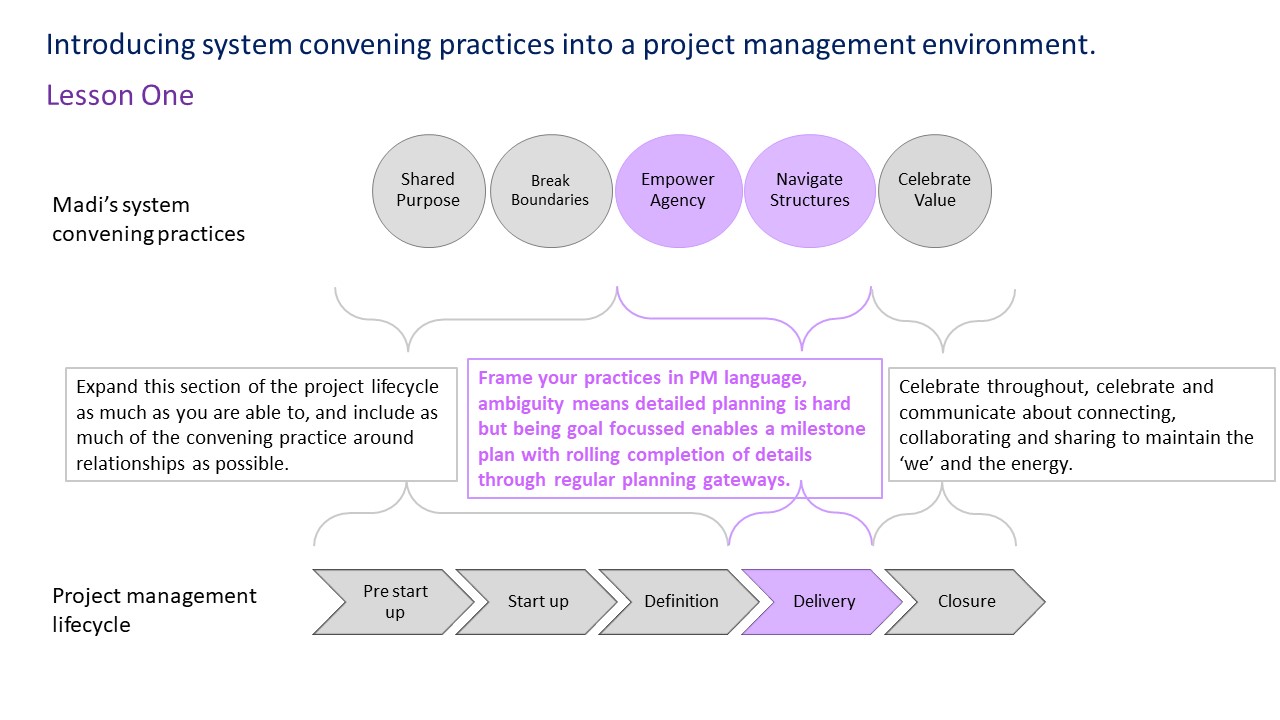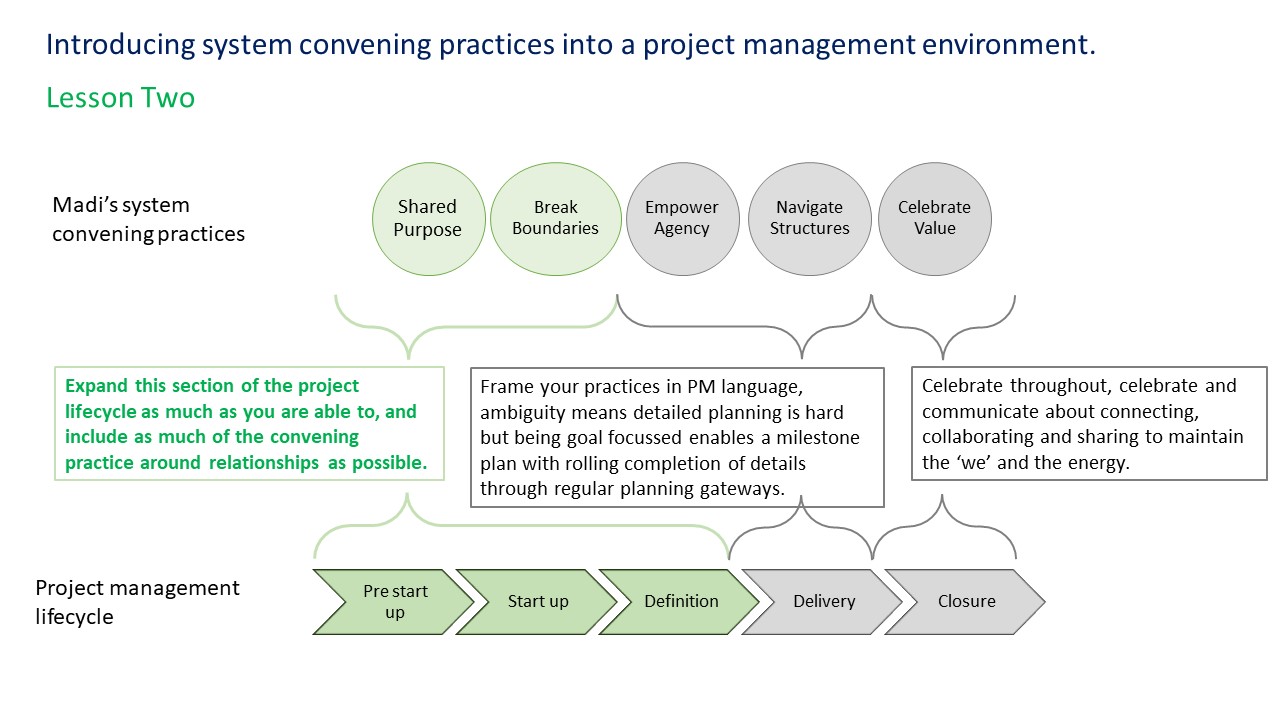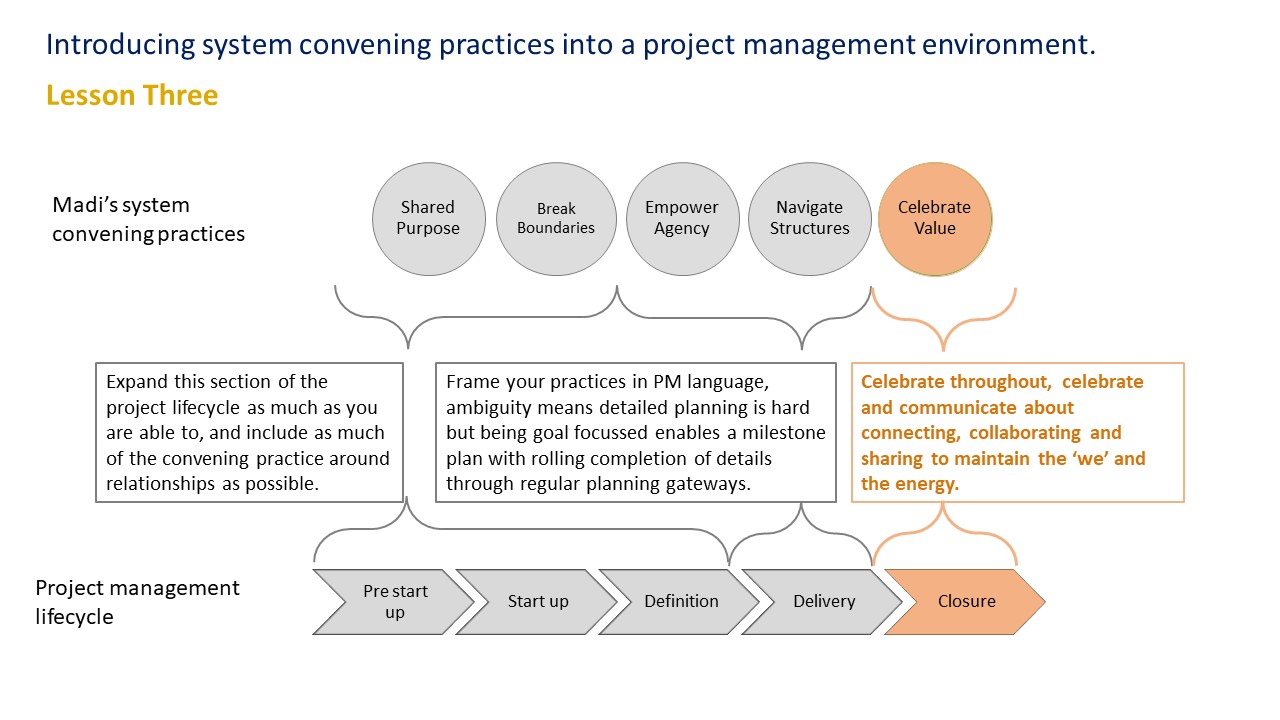Introducing Systems Convening Practices into A Project Management Environment
There is much interest in systems convening as a leadership style for enabling change in our complex health and care context. The recent Systems Convening handbook offers principles, shares insights from many people in different sectors using this approach and gives us a definition of systems convening ‘An enabling leadership activity working on sustainable change, across challenging silos, in complex social landscapes, amid changing circumstances’
Back in January 2022 we recorded a chat with Madi Hoskin (@MadiHoskin), who is featured throughout the handbook, exploring systems convening in practice. The video is here and the accompanying blog which summarises key points in the video is here.
It was great to hear such useful and practical suggestions from a voice of experience and I was keen to hear more detail on the HOW of working with systems convening and Madi kindly agreed to share more practical insights.
The complementary benefits of systems convening and project management approaches
Systems convening and programme management styles bring essential activities and complementary skills, and both are needed to enable complex change. However, the challenge of working in a complex context, aiming to enable complex change, is often made even harder by the necessity to work within a traditional programme or project management (PM) environment. Hence the topic of this blog and accompanying videos.

Madi explained to me that ‘A project management or other governance heavy environment can feel counter intuitive to a systems convener, it can feel restrictive, perhaps that your efforts aren’t appreciated, or even as though you are in the wrong place at the wrong time. This is not a reflection on you or the practices of systems convening that you believe in, but it is a reflection of the world we work in. Although it is much more comfortable for many to work as though their context or change challenge is complicated, in reality most of us working in health and social care work in a complex system'. This means we have to use leadership activities, including accountability and governance, which reflect the uncertainty and emergence that are integral to complex systems.
It is important to be clear about the important differences between a complex situation and a complicated situation. A complex situation is when you can’t predict with certainty the result of actions, there is no cause and effect, the same actions may produce a different effect each time. A complicated situation requires experience and may involve many people and steps but there is predictability and certainty that if the steps are followed the desired result will be achieved. There is a cause and effect relationship. More details on complexity in these blogs here and here.
'It can feel hard working with complexity, like you are pushing a very big rock up a very steep hill there are some ways that I have found that can help you keep progressing and make some wins along the way’.
Here Madi offers 3 lessons based on her experience of systems convening.
Lesson One – ‘A Road Map not a Project Plan’

Lesson one on how to survive working in a project management environment starts with using your convening tools inwards to inform what you do and with your framing. We know that working in a complex system means dealing with a lot of ambiguity and unknowns – this does not sit well with a traditional project management environment. In such an environment the goals are worked out early, the risks are identified and also mitigated against, the plan is drawn up and delivery progresses; however, when we are convening across a complex system, we may not know what the risks are straight away and only be able to realistically see one or perhaps two steps ahead.
Madi’s advice is to frame the shared purpose or goal you are working towards as your final outcome and begin by drawing up a roadmap to get there, if your roadmap can have some defined milestones or gateways on it even better. This way you are emulating a project plan and defining your route in an agile project management way which should satisfy your project management colleagues and give you room to define more as you go. More detail is given in the first blog with Madi here.
The video for lesson one is here starting at time point 13 minutes 42 seconds.
Madi offers the figures below as visual representations to compare her activities of systems convening with those of project management.
This lesson one of ‘a road map not a project plan’ is illustrated in purple in the figure below.

Lesson Two – Relationships – ‘Left Shift the Project Lifecycle to Give Space for Relationship Building’

The video for lesson two is here.
Madi explains that complex systems change happens at the speed of trust and through the conduit of the relationships we build and tend. You cannot rush this stage of convening if you are to be successful, building the relationships you will rely on, and between the people you are supporting, is essential and it always takes time. Often this stage is rushed or squeezed in a project management environment. Madi explained that she looks for opportunities to stretch the early parts of a project management lifecycle as much as possible and uses project management terms e.g. stakeholder mapping, RACI matrix workshop. Madi advises that working in the background you get to know the motivation of your different stakeholders, build those relationships, do the ‘invisible’ breaking down barriers between organisations and importantly connecting people to move forward together.
Madi describes a subtle way of introducing system convening practices using language familiar to project management colleagues who are our partners in enabling complex change. By articulating the stages of your relationship building in terms of early project management you can help your colleagues/team/organisation understand what you are doing and support you with it too. It might not be a perfect fit for your activities but as you progress you will also be increasing everyone’s understanding and capability in systems convening too!
This lesson two of Relationships – ‘left shift the project lifecycle to give space for relationship building’ is illustrated in green in the figure below.

Lesson Three – Celebrating – ‘Celebrate The Activities and Contributions As You Progress Don’t Just Wait Until The End Or Until The Outcomes’

The video for lesson three is here.
Madi explains the importance of celebrating as it helps maintain the energy of the people involved and can raise awareness. This is celebrating not just at the end but celebrating little wins, successes and togetherness. Celebrating some of the smaller things e.g. celebrating having an idea, can bring some joy and positivity to when people come together. This celebration is so important as complex change can take a long time and be really tough so maintaining the energy is important. Celebrating can help cement a group together around a shared purpose.
Celebrating the joy of moving forward also helps the people using systems convening keep their own energy going. Working in the background, as system convening, can be hard as people don’t understand or appreciate the work so maintaining energy is crucial.
Celebration can also bring awareness to others, including project management colleagues, of the work and success of system convening practices
‘Celebrating feels essential to bring into system convening at every stage that you can’
At every opportunity within the systems convening practices and the project management lifecycle celebrate successes that include collaboration, shared decision making, even getting things wrong, that way everyone can feel that progress is being made even if they cannot see it on a Gantt chart!
This lesson three of Celebrating – ‘celebrate the activities and contributions as you progress don’t just wait until the end or until the outcomes’ is illustrated in orange in the figure below.

Thank you again Madi for sharing your knowledge, experience and advice with us.
Madeline Hoskin is Head of Delivery: Digital and Transformation Technology and Change, North Yorkshire County Council @MadiHoskin.
More information
Systems convening handbook https://wenger-trayner.com/systems-convening/ (free pdf download).
Online space for systems conveners https://systems-convening.groups.io/g/main which includes a new sub-group for systems conveners in healthcare.
Details of future conversations and information on systems convening
- Horizons http://horizonsnhs.com/programmes-of-work/spread-and-innovation/
- Q Community https://q.health.org.uk/
Twitter - follow @MadiHoskin, @DianeKetley, @MatthewMezey, @SysConvening,
More information on system convening and the 7 spread and adoption principles is available on the NHS Horizons website.
If you're interested in how to enable the spread and adoption of innovations in healthcare, there are previous blogs and further blogs to follow. Please do subscribe to this blog and follow @DianeKetley,@HorizonsNHS, #NHSpread.
Images from Pixabay https://pixabay.com/users/rizaaprilliana46-7041959/ and https://pixabay.com/users/geralt-9301/.



/Passle/5a5c5fb12a1ea2042466f05f/MediaLibrary/Images/6168334917af5b10f4bf1d30/2022-04-14-15-27-52-040-62583d78f636e9115805b2d5.png)
/Passle/5a5c5fb12a1ea2042466f05f/MediaLibrary/Images/6168334917af5b10f4bf1d30/2022-08-05-09-59-36-465-62ecea08f636e906acfed639.jpg)
/Passle/5a5c5fb12a1ea2042466f05f/MediaLibrary/Images/6168334917af5b10f4bf1d30/2022-07-28-14-57-17-405-62e2a3cdf636e9180c9835cb.png)
/Passle/5a5c5fb12a1ea2042466f05f/MediaLibrary/Images/6168334917af5b10f4bf1d30/2022-07-20-10-16-56-533-62d7d618f636ea07987f6668.png)
/Passle/5a5c5fb12a1ea2042466f05f/MediaLibrary/Images/6168334917af5b10f4bf1d30/2022-07-15-09-55-32-858-62d13994f636ea1398e71aa9.jpg)